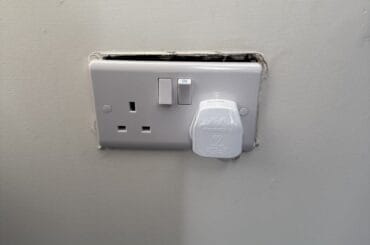
What is a Snag List? A Simple Guide
By E Shaw, Head Inspector at New Home Inspections UK With over 10 years of experience inspecting new-build properties across the UK, E SHaw is an expert in identifying and resolving construction defects.
The Guide in 60 Seconds: Key Takeaways
- What is a Snagging List? It’s a formal list of defects or incomplete work in a new-build home that the developer is legally required to fix.
- Why is it Critical? Identifying snags early protects your investment and ensures your new home meets the required quality standards. A recent survey from the Home Builders Federation (HBF) found that over 95% of new build buyers report snags to their builder.
- When to Do It: The best time is post-completion but before you move in. However, you have up to two years to report issues under your developer’s warranty.
- Who Can Do It? You can create a list yourself, but a professional snagging inspector will use their expertise and specialist tools to find defects you might miss.
Buying a new-build home is an exciting milestone. You imagine pristine walls, flawless fittings, and a perfect finish. But often, the reality includes a few teething problems—issues known in the construction world as “snags.”
Creating a snagging list is the single most important step you can take to ensure your new house truly becomes the home you paid for. This ultimate guide will walk you through exactly what a snagging list is, why it’s crucial, and how to create one that gets results.
What Exactly is a Snagging List?
A snagging list (or “punch list”) is a comprehensive document that details any and all defects in a new property at the point of handover. These aren’t major structural failures but rather issues that fall short of the agreed-upon quality standard, such as:
- Cosmetic flaws like paint splashes or scratches on windows.
- Poorly fitted installations like kitchen cabinets or doors.
- Functional problems like faulty sockets or dripping taps.
- Incomplete work like missing sealant or un-painted areas.
Essentially, if it’s not right, it goes on the list.
Why a Thorough Snagging List is Non-Negotiable
Your developer has a contractual and warranty obligation to resolve these issues. A detailed snagging list is your primary tool for holding them accountable.
Expert Insight from New Home Inspections UK: “We often find that homeowners are so excited to move in that they overlook less obvious issues,” notes David Miller, our lead inspector. “The most commonly missed snags are things like inadequate loft insulation, misaligned gutters, and unlevel floors—defects that can cause bigger problems down the line. A professional eye is trained to spot these.”
A strong list:
- Protects Your Investment: Ensures your home is worth what you paid for it.
- Saves You Money: Prevents you from having to fix issues yourself later.
- Provides Legal Proof: Creates a formal record of defects with a timestamp.
The Ultimate Snagging Checklist (2025 Edition)
You can do a snagging survey yourself. To help, we’ve created this detailed checklist. For best results, take your time, inspect in broad daylight, and bring a notepad, camera, and stickers to mark locations.
Ready for your inspection? Get our free, printable PDF version of this checklist to take with you!
Exterior
- Roof: Check for loose or cracked tiles from the ground. Are gutters and downpipes correctly aligned and free of debris?
- Brickwork & Render: Are there any cracks? Is the mortar finish consistent? Look for signs of efflorescence (white, powdery deposits).
- Windows & Doors: Do they open, close, and lock smoothly? Check for scratches on glass and frames. Is sealant applied neatly? Are trickle vents present?
- Driveway & Paths: Is the surface level and properly finished? Does water drain away correctly?
- Fencing & Gates: Are they secure? Is the finish consistent? Do gates open and close properly?
- Garden: Is the topsoil level and free of building debris? Is turf laid correctly?
General Interior
- Paint Finish: Look at walls from different angles. Is the finish even? Check for paint splashes on sockets, floors, and windows.
- Plasterwork: Are walls and ceilings smooth and level? Check for cracks, especially around sockets and switches.
- Flooring: Check for scratches, gaps, or stains on all surfaces (carpets, wood, tiles). Does the floor feel level? Are there any creaks?
- Doors: Do all doors open and close without catching on the floor or frame? Are handles and hinges secure?
- Skirting Boards: Are they fitted flush to the wall? Are corners neatly joined?
Kitchen
- Units & Worktops: Check for scratches, chips, and alignment. Do all doors and drawers open and close smoothly?
- Appliances: Test every function on the oven, hob, microwave, and dishwasher.
- Sink & Taps: Run the taps to check for leaks and water pressure. Does the sink drain properly?
- Tiling: Is the grout neat and consistent? Are there any cracked or chipped tiles?
Bathrooms & En-Suites
- Sanitaryware: Check toilets, sinks, and baths for scratches or chips. Does the toilet flush correctly?
- Taps & Shower: Check for leaks, pressure, and temperature controls. Does the shower drain properly?
- Extractor Fans: Do they work when the light is switched on?
- Sealant: Is the sealant around baths, showers, and sinks neat and complete? This is a major cause of future leaks.
- Tiling & Grouting: Check for neatness, consistency, and any damage.
Electrics, Plumbing & Heating
- Sockets & Switches: Test every single one. A simple phone charger is a great tool for this. Are they all level and flush with the wall?
- Lighting: Test all light fittings and switches.
- Radiators: Do they heat up correctly? Check for any leaks and ensure they are securely fixed to the wall.
- Thermostat: Does it accurately control the heating system?

Why is a Snag List Important?
Understanding why snag lists matter helps everyone—builders, homeowners, and inspectors. Here’s why they are important:
Makes Sure Everything is Done Right – Finds and fixes mistakes before you move in.
Prevents Arguments – A clear snag list shows what needs fixing, so there are no misunderstandings.
Keeps You Safe – Fixing problems early means fewer safety risks.
Adds Value to Your Home – A house without defects is worth more in the long run.
Makes Buyers Happy – No one likes moving into a home with problems!
Who is Responsible for a Snag List?
Different people might create and use a snag list, including:
Homeowners/Buyers – If you’re buying a new home, you should check for snags before moving in.
Site Managers – They make sure builders fix snags before handing over the home.
Surveyors and Snagging Inspectors – Professionals who find and report snags.
Contractors and Builders – The people responsible for fixing the problems.
Developers – The company that built the house must make sure it’s ready.
Where is a Snag List Used?
Snag lists are used in many places, such as:
New Homes – To check for issues before the buyer moves in.
Office Buildings – To make sure businesses get a finished space.
Renovations – To check that repair work is properly done.
Roads and Bridges – To make sure public projects are safe and complete.

How to Prepare a Snag List: A Simple Step-by-Step Guide
Powered By EmbedPress
Step 1: Walk Around and Look for Problems
Check every room, wall, floor, and ceiling.
Open and close doors and windows.
Test lights, switches, and sockets.
Flush toilets and run taps to check plumbing.
Take photos of anything that needs fixing.
Step 2: Write Everything Down
List each problem clearly, like “Scratched kitchen counter” or “Loose bathroom tile.”
Note which trade (electrician, plumber, painter, etc.) needs to fix it.
Set a deadline for the repairs.
Step 3: Organize the Snags
Urgent Issues: Safety problems and big defects.
Medium Issues: Things that affect daily life, like doors that don’t close properly.
Small Issues: Cosmetic problems, such as chipped paint.
Step 4: Share the Snag List
Give the list to the builder or site manager.
Walk through the home with them to make sure they understand.
Step 5: Check Everything Again (BACK SNAGGING INSPECTION)
Once repairs are done, go back and check that everything is fixed.
If there are still issues, ask for another round of fixes before signing off.
https://studio.youtube.com/video/Lj74vnDaJkg/edit
What is a Snag Item? Examples of Common Snags
Here are some typical problems found on snag lists:
Walls & Ceilings: Cracks, uneven paint, or rough plaster.
Floors: Loose tiles, scratched wooden floors, or bumpy carpets.
Doors & Windows: Stiff hinges, wonky locks, or gaps letting in drafts.
Plumbing: Leaky taps, low water pressure, or poor drainage.
Electrical: Faulty sockets, flickering lights, or exposed wires.
Heating & Ventilation: Radiators that don’t heat up or poor air circulation.
Tips for a Hassle-Free Snagging Process
Start Early: Don’t wait until after you move in—check for snags first!
Use a Checklist: This helps make sure you don’t miss anything.
Hire an Expert: Professional snagging inspectors know exactly what to look for.
Take Photos: Keep a record of every problem so you have proof.
Be Patient but Firm: Make sure everything is fixed properly before you accept the home.

Helpful Snagging Resources
Want to learn more? Check out these trusted sources:
RICS Home Surveys – Advice on home inspections.
NHBC Standards – Quality rules for new build homes.
UK Government Building Regulations – The legal requirements for buildings.
New Homes Inspections UK – Professional snagging services to help buyers.
1. How long does it take to complete a snag list?
It depends on the size of the home or building. A typical snagging inspection takes 3-4 hours, and repairs can take a few days to a few weeks.Default Answer
2. Can I create a snag list myself?
Yes! But hiring a professional snagging inspector ensures you don’t miss any hidden defects.
3. Do I need a snag list for a newly built home?
Absolutely! Even new homes can have defects, and a snag list helps get them fixed before you move in.Default Answer
4. Who pays for the snag list repairs?
In most cases, the builder or developer is responsible for fixing snags before handing over the property.
5. What should I do if the builder refuses to fix snags?
If your builder refuses to fix snags, check your contract and report the issue to a warranty provider like NHBC or a legal advisor.
Conclusion: Snag Lists Keep Homes Perfect!
A snag list is like a final check before a home or building is handed over. It helps fix problems before they become serious issues. Whether you’re a homeowner, builder, or inspector, following a snag list ensures a safe, well-finished home. By using the steps in this guide, you’ll be able to spot snags easily and get them fixed without hassle!
